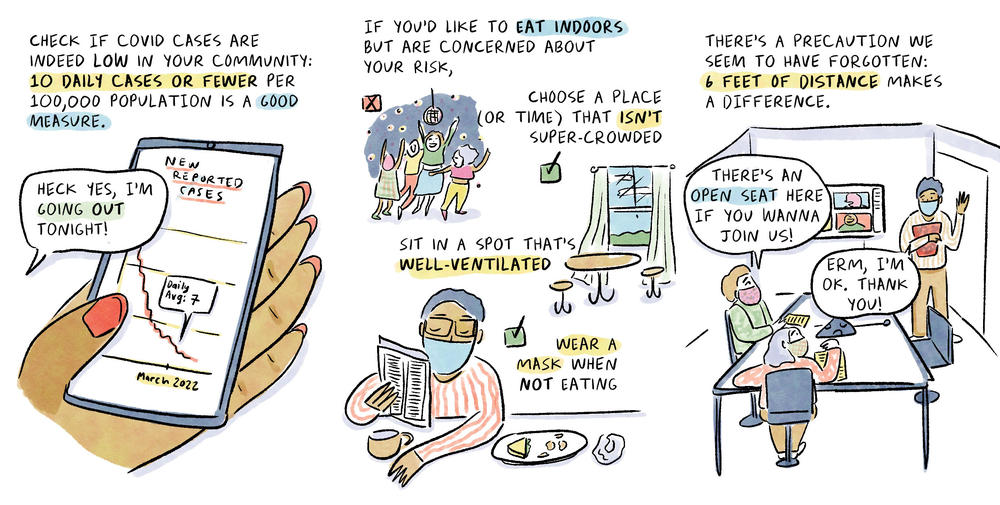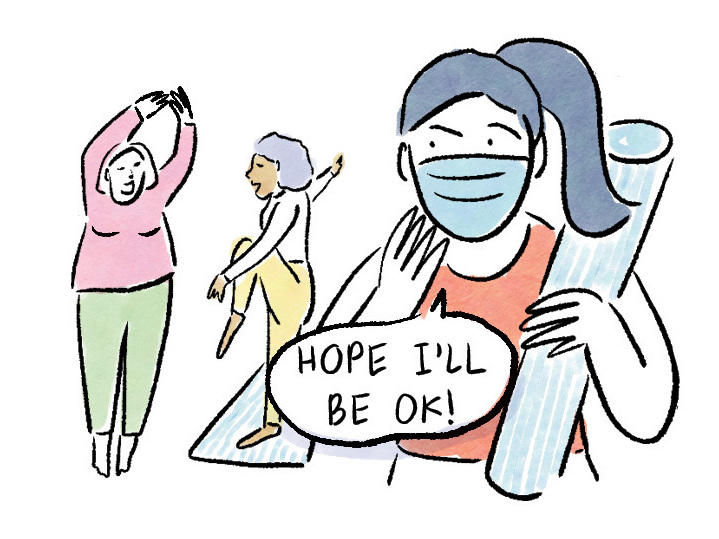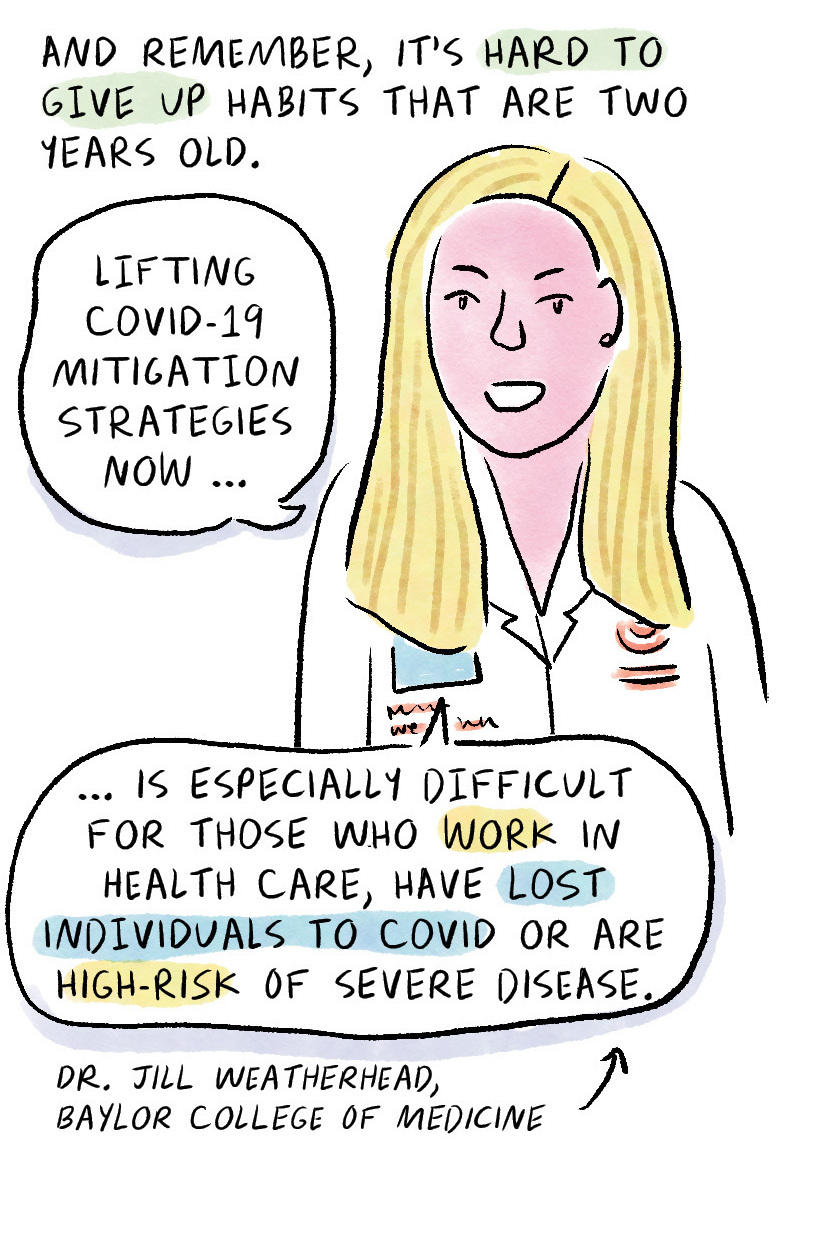Section Branding
Header Content
Coronavirus FAQ: Our mini-zine has advice on when & how to dial down COVID precautions
Primary Content
We regularly answer frequently asked questions about life during the coronavirus crisis. If you have a question you'd like us to consider for a future post, email us at goatsandsoda@npr.org with the subject line: "Weekly Coronavirus Questions." See an archive of our FAQs here.
I live in a place where case counts are dropping. I know they could go back up again, but in the meantime, what COVID precautions are advisable (if any) and what precautions can be put on hold?
First things first: The pandemic isn't over. The current surge in Hong Kong, for instance, has produced the highest reported death rate over the past two-plus years of COVID. And the U.S. still has 700 COVID deaths a day — far fewer than a couple of weeks ago but still a staggering and tragic count.
And the highly transmissible variant omicron BA.2 that's causing surges in some countries is now the dominant variant in the U.S. and could bring a surge.
But for the vaccinated and boosted in places where numbers are trending downward, times have changed — at least for the moment. Mandatory and even voluntary mask-wearing is on the wane. (If you don't believe me, come to my neighborhood coffee shop where half the servers and customers are masked and half aren't.)
If you're fortunate enough to live and work in a community where numbers are dropping, it is indeed an appropriate moment to assess your own risks and the risks of those in your inner circle. And then perhaps adjust your personal precautions.
As Dr. Preeti Malani puts it, you might decide to "dial it down" precaution-wise but also be prepared to "dial it up" if things change. She's an infectious disease doctor and the chief health officer at the University of Michigan.
For example, if you've only been an outdoor diner at restaurants, you might weigh going indoors, Malani says — keeping in mind that there are ways to minimize any potential COVID exposure.
"Maybe go when it's not super-crowded, sit in the corner where fewer people are crowded up against you or at a table where you're not that close to other people, wear a mask when you're not eating," she suggests. She also recommends picking a restaurant with good ventilation — "it matters a lot" in terms of disrupting the flow of exhaled pathogens. "I'm thinking of restaurants with high ceilings and open windows, not a cramped basement."
You also might avoid indoor settings where people are shouting a lot, she notes. "Tonight my Wolverines are playing against Villanova. I'm gonna watch it with some friends at home, not in a crowded bar."
The decision to ease up (or not) is highly personal. That's a key point made by the three experts we interviewed.
Some people are sticking with their pandemic precautions because they are at high risk of severe disease or have regular contact with others in that category. This would include the over-60 set, the immunocompromised, people who regularly see an elderly relative or babies (who are more vulnerable than toddlers).
And it's hard to give up habits that are two years old, notes Dr. Jill Weatherhead, assistant professor of adult and pediatric infectious diseases at Baylor College of Medicine. COVID-19 precautions are "engrained in your daily behaviors," she says. "Lifting mitigation strategies now can be especially difficult for those who work in health-care settings, have lost individuals to COVID-19 or are high-risk of severe disease."
Yet it's also nice to re-embrace old routines. Infectious disease doctor Abraar Karan is back in the gym and going at times when the place isn't packed and wearing a mask. When he took his mask off for a drink of water one day, he was struck by the ... er ... aroma of gyms. Which, as you may recall, is not exactly lilacs and roses. "When I was in the gym and took my mask off to drink water, I forgot how bad it stinks," he says. So that's an added benefit to wearing a mask in a place where people may be breathing heavily (and sweating as well).
Of course there will inevitably be times when you're just not sure what to do. Say you're back at work and masked and get invited to a meeting in a small room where you're uncertain about the air circulation — and where people are masked but with a variety of masks, from the less effective cloth variety to the highly effective N95/KN95.
Feeling uneasy? Karan notes that in the hospital where he works, "we have meetings like this all the time. Everyone is wearing surgical masks. And we have not had any outbreaks." Why the blue surgical masks and not the more effective N95s? Those masks were used during meetings in January and February when there were a lot of cases, he says, and there was more concern about possible transmission in staff meetings. That's not the case at this point in time. Also, surgical masks are less expensive.
And of course "you can use a higher grade mask if you have personal concerns," he says.
Another point to keep in mind: "We've forgotten that distance also makes a difference" in terms of risks of infection, says Malani. Staying six feet or so from others will reduce your risk of infection. So it's okay to avoid the main table at a meeting room — or even ask to use a Zoom option if that's possible — to reduce chances of infection.
As people assess their degree of caution, they'll also likely weigh what's happening in their life. Going on a trip or special outing? You might ramp up your protective measures say a week or so in advance so you don't come down with COVID that could result in a positive PCR test if you're flying out of the country or just put your outing on hold. That kind of pre-trip mindset can also be helpful in avoiding the fate of two of my acquaintances, who traveled out of the country and soon learned they had COVID and had to isolate in their hotel rooms for days.
Expecting a visitor who's flying in from a surge area? Have them mask up for 3 to 5 days and then take a COVID test. "That gives you a little extra assurance," says Malani.
The other thing that humanity has to keep in mind is that we all have to respect each other's choices. "The big message is that at this point [if you live in an area] with levels low, everyone has to evaluate their own risk, their own family's risk," says Weatherhead. And those decisions, she stresses, "should be respected" by all.
Copyright 2022 NPR. To see more, visit https://www.npr.org.
Bottom Content



